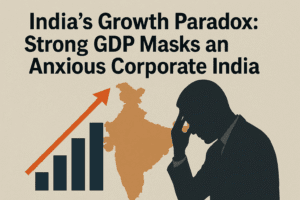India’s Growth Paradox: Strong GDP Masks a Anxious Corporate India
Despite India’s projected 6-6.5% GDP growth, a survey of business leaders reveals deep anxiety over slowing domestic demand, creating a puzzling economic contrast. While strong fundamentals like good monsoons and tax cuts exist, companies report consumers remain cautious, delaying discretionary spending. This uncertainty is compounded by significant external threats, namely new US tariffs that threaten a substantial portion of India’s exports.
Consequently, private investment has stalled, with most firms freezing capital expenditure plans until they see more stable, sustained demand. In response, the government is forced to shoulder the growth burden by ramping up its own infrastructure spending. However, glimmers of hope remain in a potential rural revival from robust crop yields and resilient urban disposable incomes. Ultimately, navigating these contrasting headwinds and tailwinds makes for a challenging yet critical year for India’s economic trajectory.

India’s Growth Paradox: Strong GDP Masks a Anxious Corporate India
India is poised to become the world’s fourth-largest economy, racing ahead with a projected GDP growth of 6-6.5% in FY26—the fastest among major economies. Yet, beneath this headline of robust expansion, a undercurrent of anxiety is gripping corporate boardrooms. A recent survey of 500 CEOs and CFOs reveals a business community caught between the promise of domestic potential and the peril of global uncertainty.
The latest BT-C Fore Business Confidence Index (BCI) nudged up to 50.2 in Q1 FY26 from a 15-quarter low of 47.7. While this move out of the “negative sentiment” zone (below 50) is a relief, it’s the second-lowest reading in over three years. This muted optimism, despite falling inflation, a supportive RBI, and good monsoon rains, points to a complex economic reality where strong fundamentals are being tested by significant headwinds.
The Domestic Demand Dilemma
The most pressing concern for 54% of surveyed companies is a palpable slowdown in domestic demand. This is the core of the paradox. On paper, everything is set for a consumption boom: a population of 1.45 billion, tax cuts putting more money in urban pockets, good harvests boosting rural incomes, and easing loan EMIs.
However, businesses are in a “wait-and-watch” mode. As one economist notes, companies need to see sustained demand before committing fully. High-profile layoffs in sectors like IT and modest salary hikes have made consumers cautious, delaying discretionary spending. The engine of the Indian economy—its vast consumer base—is sputtering slightly, and everyone is listening intently to the sound.
The Trump Tariff Tremor
Adding to domestic jitters is an external shock from the world’s largest economy. The US administration’s imposition of a 25% tariff on imports, plus an additional 25% “penalty” on nations trading with Russia, has directly targeted a significant portion of Indian exports.
While only 19% of firms in the pre-hike survey felt immediately impacted, the economic reality is stark. Analysts at Morgan Stanley estimate that 67% of India’s exports to the US, worth about $58 billion (1.5% of GDP), are now vulnerable. This has prompted major rating agencies like ICRA, Fitch, and Barclays to shave 0.2-0.3% off their FY26 GDP forecasts, warning of a larger impact if the tariffs persist.
The government is scrambling to diversify export markets through deals with the EU, New Zealand, and the UK. Notably, 67% of business leaders believe the recently signed UK-India FTA and a potential US deal will be beneficial, viewing them as critical lifelines in a more fragmented global trade environment.
The Capex Conundrum: Where’s the Investment?
Perhaps the most telling sign of caution is the freeze in private capital expenditure (capex). Despite a 100-basis point rate cut from the RBI in preceding months, a staggering 57% of companies surveyed have no plans for new capital investments this fiscal year.
The reason is a classic chicken-and-egg problem. Businesses won’t invest in new capacity until they see strong, sustained demand. But without investment, job creation and income growth remain subdued, which in turn caps demand. The RBI data shows manufacturing capacity utilization at 77.7%—healthy, but not yet at the 80%+ levels that typically trigger major investment cycles.
This places the entire burden of driving growth on the government’s shoulders. With traditional infrastructure ministries like roads and railways nearing peak spending capacity, the Centre is now pushing into urban infrastructure and ports, while urgently prodding states to ramp up their own capex.
Glimmers of Hope: The Green Shoots
Despite the challenges, there are solid reasons for resilience.
- Rural Revival: Experts point to two consecutive robust cropping seasons and an “above-normal” monsoon forecast as key catalysts for reviving rural demand, a critical piece of the consumption puzzle.
- The Urban Wallet: Tax cuts, lower EMIs, and moderating inflation are increasing disposable income for the urban salaried class, which should eventually fuel spending on services, automobiles, and housing.
- Inflation Control: With retail inflation at a six-year low of 2.1% and expectations firmly anchored, the RBI has the room to support growth, and consumers are less anxious about price rises.
The Road Ahead: A Delicate Balancing Act
FY26 is shaping up to be a year of navigating contrasts. The government is walking a tightrope, using its own balance sheet to fund growth while hoping private investment will soon kick in. Businesses are hedging their bets, optimistic about India’s long-term story but cautious in their short-term actions.
The upcoming GDP data and the evolution of US trade negotiations will be critical indicators. For now, India’s economy is like a powerful engine running well below its RPM limit. The fundamentals are strong, but it will take a blend of sustained consumer confidence, global trade stability, and policy certainty to finally put the pedal to the metal. The journey to sustained, broad-based growth continues, but the path is proving bumpier than expected.
You must be logged in to post a comment.